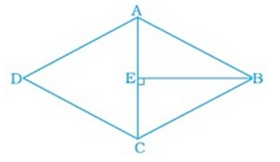8th Grade > Mathematics
MENSURATION MCQs
:
B
Area of the rectangular playground = length × breadth
= 60 × 25 = 1500 m2.
:
Given, the radius (r) is 14cm.
Let h be the height of the cylinder.
Total surface area of cylinder = 2 π r2 + 2 π r h
2640 = 2 x 227 x (14)2 + 2 x 227 x(14) h .
Hence, h = 16 cm.
:
C
We can calculate the area of this quadrilateral as the sum of the areas of two triangles taking diagonal length 25m as the base for both triangles and perpendicular length 8m as the height of one triangle and the perpendicular length 12m as the height of another triangle.
Area of triangle = 12×base×height
Area of the first triangle = 12×25×8
Area of the second triangle = 12×25×12
Area of quadrilateral = Area of the first triangle + Area of the second triangle
Area of quadrilateral = 12(25)(8+12)=250m2
:
B
Let l be the length, b be the breadth and h be the height of a cuboid.
The formula for finding the total surface area of the cuboid is 2×(lb+bh+hl).
:
C
The metal sheet is in the shape of a cuboid.
Total surface area of the cuboid is given by 2 (lb + bh + hl) = 2[(27 ×8) + (8 ×1) + (1 ×27)] = 502 cm2.
When the metal sheet is melted into a cube, then the volume of the metal sheet will be equal to the volume of the cube.
Hence, Volume of the cuboid = Volume of the cube
Let each side of the cube be a
Hence, 27 × 8 × 1 = a3
⇒a = 6 cm
Total Surface area of the cube is given by 6a2 = 6 × (6)2 = 216 cm2.
Hence, the difference between surface areas of two solids = (502 -216) cm2 = 286 cm2.
:
A
Edge of the cube (a) = 2.5 m
Area of four walls = 4a2
= 4 x 2.5 x 2.5 m2 = 25 m2
:
C
Let the length of the other parallel side be a.
Given, one of the sides is 20 m and the distance between two parallel sides is 15 m.
The area of trapezium is given by
=12× Sum of the length of the two parallel sides × Distance between the two parallel sides.
Hence,
600 = 12 (a + 20) × 15
a + 20 = 80
a = 80 – 20 = 60
Hence, the length of the other parallel side = 60 m
:
D
Let the length of one diagonal be x units.
The length of the other diagonal is 2x units
Applying Pythagoras theorem,
2×(side of square)2=(length of diagonal)2
⇒(side of square)2
= 12×(length of diagonal)2
Sides of the squares will be √4x22=2x√2
and √x22=x√2
Area of square = (side of square)2
Hence the ratio of the area of squares is (2x√2)2 and (x√2)2
= 12×(2x)2:12×x2
= 4: 1
:
A
Since area of a square has to be calculated, whose diagonal length is 16√2 meters. The relation between diagonal and side of a square is :
a√2=d, where, a = side of the square and d = length of diagonal (from Pythagorean theorem)
⇒a√2=16√2
⇒ a=16m.
Therefore, area is given by:
A = a2
⇒A=162=256m2.
:
D
The diagonals of a rhombus bisect each other. Therefore, in the given figure:
⇒BE=DE
⇒BD=2×BE
⇒BD=2×8=16 cm
Area of a rhombus equals half the product of length of the two diagonals.
⇒Area of ABCD = 12×AC×BD
⟹Area of ABCD= 12×12×16=96 cm2.

















